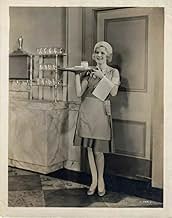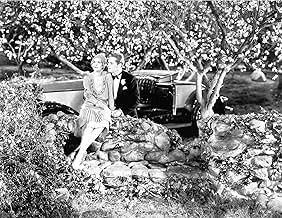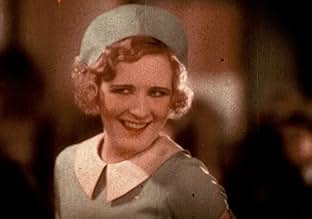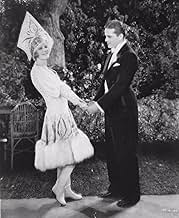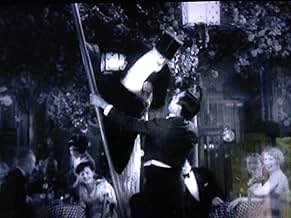Aggiungi una trama nella tua linguaSally was an orphan who got her name from the telephone exchange where she was abandoned as a baby. In the orphanage, she discovered the joy of dancing. Working as a waitress, she goes from ... Leggi tuttoSally was an orphan who got her name from the telephone exchange where she was abandoned as a baby. In the orphanage, she discovered the joy of dancing. Working as a waitress, she goes from job to job until she finds a job that also allows her to dance. At the restaurant, she mee... Leggi tuttoSally was an orphan who got her name from the telephone exchange where she was abandoned as a baby. In the orphanage, she discovered the joy of dancing. Working as a waitress, she goes from job to job until she finds a job that also allows her to dance. At the restaurant, she meets Blair and they fall for each other, but Blair is engaged to Marcia. Sally is hired to i... Leggi tutto
- Regia
- Sceneggiatura
- Star
- Candidato a 1 Oscar
- 1 vittoria e 1 candidatura in totale
- Undetermined Role
- (non citato nei titoli originali)
- Cafe Customer
- (non citato nei titoli originali)
- Chorus Girl
- (non citato nei titoli originali)
- Party Guest
- (non citato nei titoli originali)
- Cafe Customer
- (non citato nei titoli originali)
- Girls in dance number
- (non citato nei titoli originali)
Recensioni in evidenza
Supporting her is a very young Joe E Brown (best known as Captain Andy in the third film version of Show Boat) who is a lot of fun, and Alexander Gray, who like many other leading men of the early talkies is a bit of a stuffed shirt. You'll also spot the Keystone Kops' Ford Sterling as 'Pops'.
'Sally' is a hugely enjoyable early talkie. The colour sequence is lovely and bright - it is a pity that we lose the impact from the rest of the film. The songs are good and Miss Miller is a treat to watch. Try to catch this when it next airs on TCM.
The story is adapted from the Ziegfeld show of the same name. It is about Sally Green (Marilyn Miller), an orphaned girl who waitresses and cooks in a diner for a living, but dreams of being a professional dancer. In fact, the very first shots of the film are of Miller's feet as she dances while she works. She also has an admirer (Alexander Grey) who stares at her from outside the café where she works, causing her to get so enthralled in his gaze one day that she inadvertently makes the world's largest pancake. Sally is basically a Cinderella story, and a charming one at that. There is no evil stepmother in this fairy tale, however, so you can just sit back and enjoy this light romantic comedy and its beautiful musical numbers. The romance is provided by Alexander Gray and Marilyn Miller, and the comedy is mainly provided by Joe E. Brown. Brown plays a prince made penniless by a revolution in his country of origin who now works at the restaurant with Sally and is also her good friend. One of the most delightful scenes in the film is where the two dance to "Look for the Silver Lining" with Miller doing her more formal interpretation alongside Brown's eccentric dancing.
Someone else compared Marilyn Miller to Irene Dunne, and there is one scene where that is particularly true. An agent has a famous dancer client who has run out on him the night before she is to perform at a big society party. Sally helps him out by impersonating that dancer complete with a ridiculous accent and an outlandish headdress. This comedy bit very much reminded me of something Irene Dunne would do.
The film was originally shot in two-strip Technicolor, but only one color scene still exists. That one scene is Miller dancing to "Wild Rose" at a society party, and the colors there are truly splendid. As soon as the Technicolor kicks in, for some reason, so does a higher quality level on the sound. Highly recommended for the fans of the early talkie musicals.
** 1/2 (out of 4)
Better than average Musical from Warner about a down on her luck waitress (Marilyn Miller) who dreams of making it big as a dancer and finally gets a shot thanks to a man (Alexander Gray) who turns out to also be a major love interest. This story was a big hit on Broadway and it was even made into a film in 1925 but it seems it has now been forgotten as has its star Miller. Miller was apparently one of the biggest names on Broadway and she was making her film debut here but she's end up dead a short seven-years later due to alcohol and health problems. Many consider this her shining moments and she certainly leaves an impression even if it wasn't the one I was expecting. The actual story here will probably strike many as being unoriginal but one must remember that this movie came before many future films that would follow the same Cinderella-type structure. The one problem I had with the structure is that it seemed like Miller became famous way too quickly but this is just a minor thing. I went into this thing expecting great music numbers and poor "acting" but I actually got the opposite. I thought the entire cast delivered fine performances and they actually made the story flow a lot better than it would have with other actors. Gray has a very good voice but he also handles the role quite well and makes a memorable character. Joe E. Brown is here for comic relief and nearly steals the film in a couple classic scenes. One has an old man paying him some extra money to get into the club so Brown makes him climb a ladder to reach a tree house. Another laugh riot follows when Brown makes life Hell on a guy who comes to the club to impress a girl but doesn't have enough cash to pay for what she wants. I think most people are going to be checking this film out to get a glimpse of Miller and she's certainly very easy on the eyes. Her acting range really impressed me as she came off quite natural and I thought she was very believable as the girl dreaming for something big. I thought her dancing scenes were terrific and her comic timing was able to match Brown's and the two appear to be having fun together. The strange thing is that I wasn't overly impressed with her voice, which is something most other reviewers really praised. It wasn't horrible but I just didn't really get into it. The film was originally released in 2-strip Technicolor but sadly that version has gone missing so we're left with a B&W print that features the only remaining color footage, which lasts around three-minutes. It's a real shame that the color stuff is missing but the footage that does survive is in pretty rough shape but then again the B&W print is in tough shape.
In 1929 she made "Sally" for First National (forerunner of Warner Bros.) in which she recreated one of her stage triumphs. It is good and with some competent back-up supporting actors, but I would say it is an incomplete document if one is trying to 'discover' Marilyn Miller. The story is familiar, about a waitress looking for her big show biz break with a romantic side-story, and she shows her star appeal as a passable singer, a better actress and an even better dancer. She is pretty in a familiar sort of way, but she wins you over with her vivacious, cheerful demeanor.
The website rating is about right, and you get the feeling that being captured on film in an unremarkable story doesn't do her justice. I haven't seen her other films but I am reasonably certain that they do not capture the full impact of this legendary performer, either. I guess we'll just have to rely on historical sources and those three films.
This is the second of three films starring Miller, who was a huge star on Broadway in the 1920s as Ziegfeld Follies' lead actress. Miller only lived to be 37.
This film desperately needs to be restored. It could be a pretty good film. Although the story is pedestrian, some of the scenes are funny, although much of the humor is buried in poor sound quality. The film features early Vitaphone audio, which synchronized record albums with film. This can make restoration a particular challenge. The records were fragile and were only meant to be played a few times before they were replaced. If the discs are gone, what's left is whatever dub was made onto film long ago.
Lo sapevi?
- QuizOriginally presented in 100% two-color Technicolor, at present the complete film survives only in black and white, with a singular musical number, "Wild Rose," in color.
- Citazioni
Otis Hooper: [to 'Connie', the waiter] I have 10 bucks - and only 10 bucks.
[opens the menu]
Otis Hooper: What would you suggest?
'Connie': Another restaurant.
- ConnessioniFeatured in Broadway: The American Musical (2004)
- Colonne sonoreSally
(1920) (uncredited)
Music by Jerome Kern
Lyrics by Clifford Grey
Played during the opening credits and often in the score
Sung by Alexander Gray and Chorus
Danced by Marilyn Miller and Joe E. Brown
Danced by Miller and Albertina Rasch Dancers at the follies
I più visti
Dettagli
Botteghino
- Budget
- 647.000 USD (previsto)
- Tempo di esecuzione
- 1h 43min(103 min)


